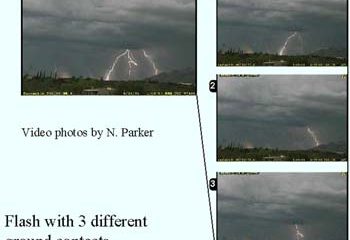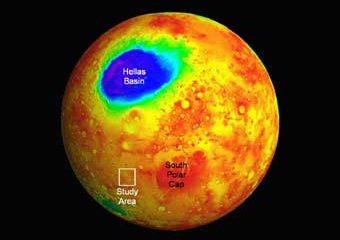Earth Sciences
Earth Sciences (also referred to as Geosciences), which deals with basic issues surrounding our planet, plays a vital role in the area of energy and raw materials supply.
Earth Sciences comprises subjects such as geology, geography, geological informatics, paleontology, mineralogy, petrography, crystallography, geophysics, geodesy, glaciology, cartography, photogrammetry, meteorology and seismology, early-warning systems, earthquake research and polar research.

Lightning really does strike more than twice
NASA-funded scientists have recently learned that cloud-to-ground lightning frequently strikes the ground in two or more places and that the chances of being struck are about 45 percent higher than what people commonly assume.
Recently, William C. Valine and E. Philip Krider in the Institute of Atmospheric Physics at the University of Arizona, co-authors of the study, took to the field using video and other technology to study lightning, which is one of the biggest weather-related killers i

UMass study reconsiders formation of Antarctic ice sheet
Findings detailed in Jan. 16 issue of Nature; greenhouse gases implicated
A study by University of Massachusetts Amherst geoscientist Robert DeConto posits an alternative theory regarding why Antarctica suddenly became glaciated 34 million years ago. The study challenges previous thinking about why the ice sheet formed and holds ramifications for the next several hundred years as greenhouse gases continue to rise. DeConto, who collaborated with David Pollard of Pennsylvania State Univ

Giant elephant tusk found in desert: find thought to be eight million years old
Two University of York graduates have found and preserved the giant tusk of the largest elephant fossil of its type ever to be found in the Middle East.
The tusk, two-and-a-half metres long and thought to be between six and eight million years old, was discovered by Dr Mark Beech, who finished his PhD at York recently and is now senior resident archaeologist for the Abu Dhabi Islands Archaeological Survey (ADIAS).
Mark discovered the tusk in Abu Dhabi’s Western Region last October

Dinosaurs experienced climate changes before K-T collision
Climate change had little to do with the demise of the dinosaurs, but the last million years before their extinction had a complex pattern of warming and cooling events that are important to our understanding of the end of their reign, according to geologists.
“The terrestrial paleoclimate record near the K-T is historically contradictory and poorly resolved,” says Dr. Peter Wilf, assistant professor of geosciences at Penn State. “In contrast, the resolution of K-T marine climates that has

Hunt for life on Mars dealt another blow
An Australian geologist has identified what could be the first ever active flow of fluids through gullies on Mars.
University of Melbourne geologist, Dr Nick Hoffman, identified recent gully and channel development near the polar regions of Mars from images taken by the Mars Global Surveyor spacecraft. But contrary to the majority of scientific opinion which suggests that such features were carved by liquid water, Hoffman says the flow is most likely frozen carbon dioxide.

Scientists discover global warming linked to increase in tropopause height over past two decades
Researchers at the Lawrence Livermore National Laboratory have discovered another fingerprint of human effects on global climate.
Recent research has shown that increases in the height of the tropopause over the past two decades are directly linked to ozone depletion and increased greenhouse gases.
The tropopause is the transition zone between the lowest layer of the atmosphere — the turbulently-mixed troposphere — and the more stable stratosphere. The tropopause lies rough